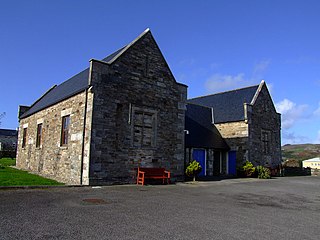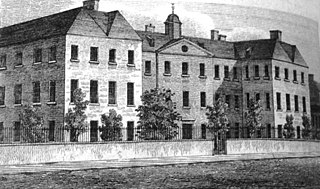Related Research Articles

The English Poor Laws were a system of poor relief in England and Wales that developed out of the codification of late-medieval and Tudor-era laws in 1587–1598. The system continued until the modern welfare state emerged in the late 1940s.

In Britain and Ireland, a workhouse was a total institution where those unable to support themselves financially were offered accommodation and employment. In Scotland, they were usually known as poorhouses. The earliest known use of the term workhouse is from 1631, in an account by the mayor of Abingdon reporting that "we have erected wthn [sic] our borough a workhouse to set poorer people to work".

The Local Government (Ireland) Act 1898 was an Act of the Parliament of the United Kingdom of Great Britain and Ireland that established a system of local government in Ireland similar to that already created for England, Wales and Scotland by legislation in 1888 and 1889. The Act effectively ended landlord control of local government in Ireland.
A poorhouse or workhouse is a government-run facility to support and provide housing for the dependent or needy.

A vestry was a committee for the local secular and ecclesiastical government of a parish in England, Wales and some English colonies, which originally met in the vestry or sacristy of the parish church, and consequently became known colloquially as the "vestry". At their height, the vestries were the only form of local government in many places and spent nearly one-fifth of the budget of the British government. They were stripped of their secular functions in 1894 and were abolished in 1921.

The Poor Law Amendment Act 1834 (PLAA) known widely as the New Poor Law, was an Act of the Parliament of the United Kingdom passed by the Whig government of Earl Grey denying the right of the poor to subsistence. It completely replaced earlier legislation based on the Poor Relief Act 1601 and attempted to fundamentally change the poverty relief system in England and Wales. It resulted from the 1832 Royal Commission into the Operation of the Poor Laws, which included Edwin Chadwick, John Bird Sumner and Nassau William Senior. Chadwick was dissatisfied with the law that resulted from his report. The Act was passed two years after the Representation of the People Act 1832 which extended the franchise to middle-class men. Some historians have argued that this was a major factor in the PLAA being passed.

The Andover workhouse scandal of the mid-1840s exposed serious defects in the administration of the English 'New Poor Law'. It led to significant changes in its central supervision and to increased parliamentary scrutiny. The scandal began with the revelation in August 1845 that inmates of the workhouse in Andover, Hampshire, England were driven by hunger to eat the marrow and gristle from bones which they were to crush to make fertilizer. The inmates' rations set by the local Poor Law guardians were less than the subsistence diet decreed by the central Poor Law Commission (PLC), and the master of the workhouse was diverting some of the funds, or the rations, for private gain. The guardians were loath to lose the services of the master, despite this and despite allegations of the master's drunkenness on duty and sexual abuse of female inmates. The commission eventually exercised its power to order dismissal of the master, after ordering two enquiries by an assistant-commissioner subject to a conflict of interest; the conduct of the second led to more public inquiry and drew criticism.

The Poor Relief Act 1601 was an Act of the Parliament of England. The Act for the Relief of the Poor 1601, popularly known as the Elizabethan Poor Law, the "43rd Elizabeth", or the "Old Poor Law", was passed in 1601 and created a poor law system for England and Wales.
An overseer of the poor was an official who administered poor relief such as money, food, and clothing in England and various other countries which derived their law from England, such as the United States.

In English and British history, poor relief refers to government and ecclesiastical action to relieve poverty. Over the centuries, various authorities have needed to decide whose poverty deserves relief and also who should bear the cost of helping the poor. Alongside ever-changing attitudes towards poverty, many methods have been attempted to answer these questions. Since the early 16th century legislation on poverty enacted by the Parliament of England, poor relief has developed from being little more than a systematic means of punishment into a complex system of government-funded support and protection, especially following the creation in the 1940s of the welfare state.
From the reign of Elizabeth I until the passage of the Poor Law Amendment Act 1834 relief of the poor in England was administered on the basis of a Poor Relief Act 1601. From the start of the nineteenth century the basic concept of providing poor relief was criticised as misguided by leading political economists and in southern agricultural counties the burden of poor-rates was felt to be excessive (especially where poor-rates were used to supplement low wages. Opposition to the Elizabethan Poor Law led to a Royal Commission on poor relief, which recommended that poor relief could not in the short term be abolished; however it should be curtailed, and administered on such terms that none but the desperate would claim it. Relief should only be administered in workhouses, whose inhabitants were to be confined, 'classified' and segregated. The Poor Law Amendment Act 1834 allowed these changes to be implemented by a Poor Law Commission largely unaccountable to Parliament. The act was passed by large majorities in Parliament, but the regime it was intended to bring about was denounced by its critics as un-Christian, un-English, unconstitutional, and impracticable for the great manufacturing districts of Northern England. The Act itself did not introduce the regime, but introduced a framework by which it might easily be brought in.

The 1832 Royal Commission into the Operation of the Poor Laws was a group set up to decide how to change the Poor Law systems in England and Wales. The group included Nassau Senior, a professor from Oxford University who was against the allowance system, and Edwin Chadwick, who was a Benthamite. The recommendations of the Royal Commission's report were implemented in the Poor Law Amendment Act 1834.
Boards of guardians were ad hoc authorities that administered Poor Law in the United Kingdom from 1835 to 1930.

The Irish poor laws were a series of acts of Parliament intended to address social instability due to widespread and persistent poverty in Ireland. While some legislation had been introduced by the pre-Union Parliament of Ireland prior to the Act of Union, the most radical and comprehensive attempt was the Poor Relief (Ireland) Act 1838, closely modelled on the English Poor Law Amendment Act 1834. In England, this replaced Elizabethan era legislation which had no equivalent in Ireland.
The Scottish poor laws were the statutes concerning poor relief passed in Scotland between 1579 and 1929. Scotland had a different poor law system to England and the workings of the Scottish laws differed greatly to the Poor Law Amendment Act 1834 which applied in England and Wales.
The Historiography of the Poor Laws can be said to have passed through three distinct phases. Early historiography was concerned with the deficiencies of the Old Poor Law system, later work can be characterized as an early attempt at revisionism before the writings of Mark Blaug present a truly revisionist analysis of the Poor Law system.
Poor Law policy after the New Poor Law concerns the time period c. 1847–1900 after the implementation of the Poor Law Amendment Act until the beginnings of the decline of the Poor Law system at the start of the 20th century.

The Poor Relief (Ireland) Act 1838 is an Act of the Parliament of the United Kingdom that created the system of poor relief in Ireland. The legislation was largely influenced by the English Poor Law Amendment Act 1834.

Moycarkey is an electoral division in County Tipperary in Ireland. It was originally an electoral division in the Thurles Poor Law Union in North Tipperary but is still used for various administrative purposes.

The Scottish poorhouse, occasionally referred to as a workhouse, provided accommodation for the destitute and poor in Scotland. The term poorhouse was almost invariably used to describe the institutions in that country, as unlike the regime in their workhouse counterparts in neighbouring England and Wales, residents were not usually required to labour in return for their upkeep.
References
- 1 2 "Encyclopedia: English Poor Laws". Eh.net. 7 May 2002. Archived from the original on 5 January 2010. Retrieved 14 March 2010.
- ↑ "The Poor Law: overview". Victorianweb.org. 8 November 2002. Retrieved 14 March 2010.
- ↑ "British social policy 1601–1948". .rgu.ac.uk. Archived from the original on 20 July 2007. Retrieved 14 March 2010.
- ↑ Blaug, Mark. "The Poor Law Report Re-examined." Journal of Economic History (1964) 24: 229–45
- ↑ Poverty and Poor Law Reform in Nineteenth-Century Britain, 1834–1914, David Englander (2013)
- ↑ "The implementation of the Poor Law". Victorianweb.org. 12 November 2002. Retrieved 14 March 2010.
- ↑ Poor Relief (Ireland) Act 1838 ( 1 & 2 Vict.,c. 56 of 1838 ). Enacted on 31 July 1838. Act of the UK Parliament .Retrieved from Irish Statute Book on 6 May 2016.
- ↑ "History & Heritage > Poor Law Union > Poor Law Unions and their Records > The Union". AskAboutIreland. An Chomhairle Leabharlanna. Retrieved 6 May 2016.
- ↑ O'Brien, Gerard (November 1982). "The Establishment of Poor-Law Unions in Ireland, 1838–43". Irish Historical Studies. 23 (90). Cambridge University Press: 97–120. doi:10.1017/S0021121400017545. JSTOR 30008402. S2CID 163411266.
- ↑ Nicholls, George (1856). A History of the Irish Poor Law: In Connexion with the Condition of the People. J. Murray. p. 423 . Retrieved 6 May 2016.
- 1 2 "History & Heritage > Poor Law Union > Poor Law Unions and their Records > The Establishment of the Poor Law System". AskAboutIreland. An Chomhairle Leabharlanna. Retrieved 6 May 2016.
- ↑ "Browse > Census > 1871 > Ireland > Alphabetical index to townlands of Ireland, 1871". HISTPOP.ORG. Retrieved 6 May 2016.
- ↑ "Adaptation Of Children's Act 1908 Order 1925". Irish Statute Book . 27 May 1925. Retrieved 6 May 2016.
- ↑ Higginbotham, Peter. "The Workhouse in Scotland". The Workhouse Web Site. Retrieved 7 March 2011.
- ↑ Higginbotham, Peter. "Poorhouses in Scotland". The Workhouse Web Site. Retrieved 7 March 2011.
